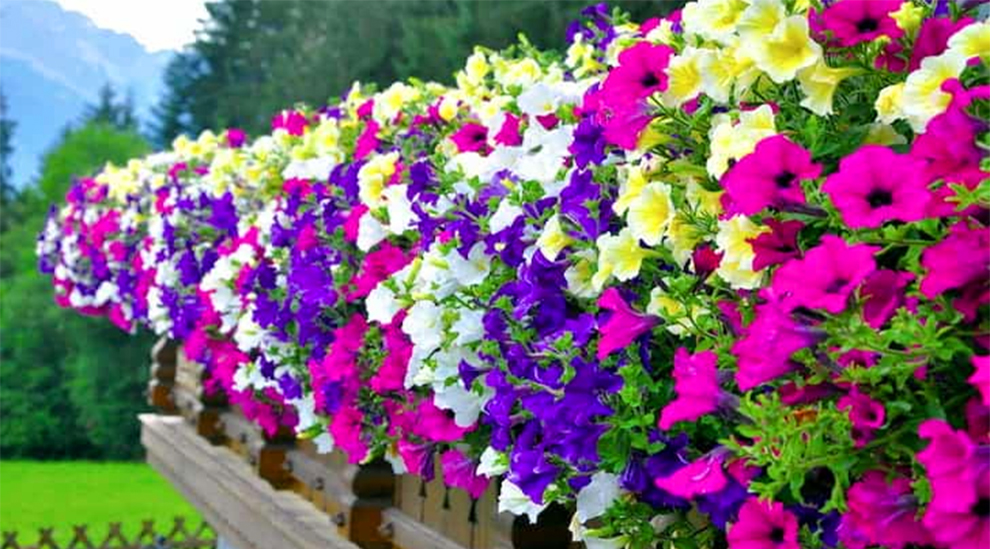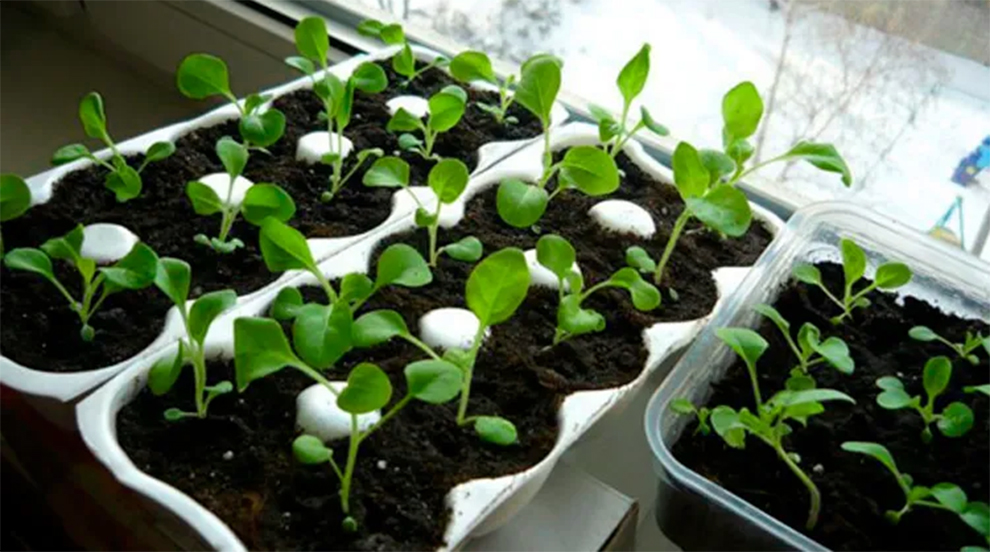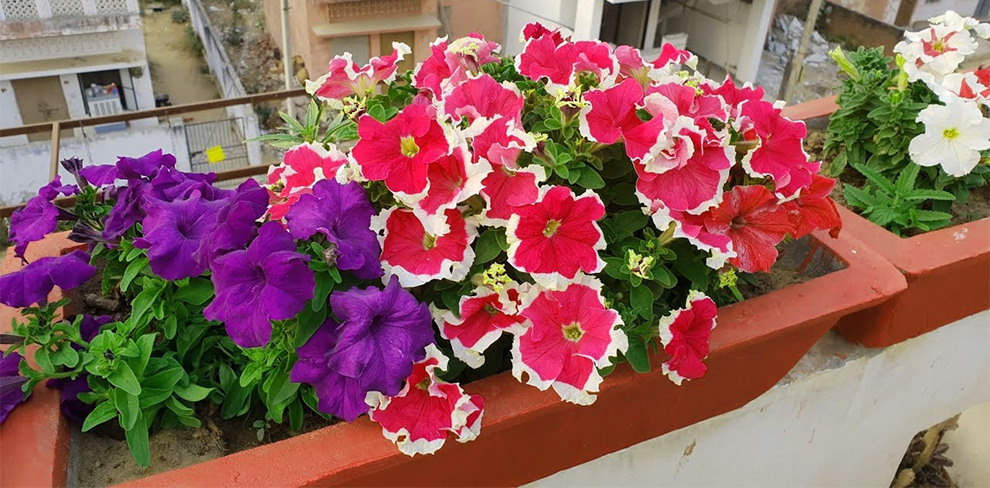Petunia Growth Rate – How Fast Is It?
Petunias have a moderate growth rate. Although they do not grow very tall on maturity but they spread wide.

Generally speaking, Petunias are not very fast-growing plants. They add vibrant color and beauty to containers, landscapes, and gardens.
Understanding how fast do petunias grow is crucial for gardeners to plan in advance about the future requirements of the plant. This includes catering to their fertilizer needs, changing watering frequency, spacing, planting time, identifying potential issues, and other care requirements, etc.
Different factors, including sunlight, soil type, temperature, and the variety planted, will determine the growth rate of petunias.
Petunias grow at a moderate growth rate. They approximately grow 6-24 inches in height on maturity within a period of 6-8 weeks. They spread up to 12-24 inches in a single growing season. However, some petunia varieties can grow larger.
With proper attention and care, petunias can offer a profusion of blooms across the growing season, adding beauty and vibrant color to any outdoor space.
Is Petunia Growth Rate Fast or Slow?

Petunia varieties are moderately growing plants and may have varying growth rates depending on the available growing conditions and the specific variety.
On average, they become 6-12 inches in height and spread to 12-24 inches wide in one growing season. However, some, like Supertunia, grow 24 to 36 inches wide. Grandiflora petunias grow slower than spreading or multiflora petunias.
Generally, petunia plants grow the fastest in the summer and spring when the temperature is warm and the daylight hours are long.
A. How Fast Do Wave Petunias Grow?
Wave petunias are famous for their fast growth, however, it is not possible to determine the exact growth rate of petunias.
As for height, they grow up to 6-12 inches tall and spread up to 3-4 feet wide in a single growing season. Wave Petunias typically bloom early and continue to produce flowers across the growing season until the first frost.
With proper care, the Wave Petunias can grow to their full potential and size within a single growing season, making them an impeccable choice for gardeners seeking low-maintenance, fast-growing plants with a long bloom period.
B. How fast do Grandiflora Petunias grow?
Grandiflora petunias are another popular petunia variety famous for their showy, large blooms. They grow up to five inches in diameter. They are moderate growers, meaning they grow at a moderate pace compared to the other petunia varieties.
Typically, the growth rate for Grandiflora petunias is influenced by an array of factors, such as soil quality, weather, growing conditions, and petunia care practices. As for the size, the Grandiflora petunias grow up to 12-15 inches in height with an 18-24 inches spread.
These varieties profusely bloom in late spring and yield flowers across the fall and summer months until the first frost. With good care, these petunias can offer an attractive appeal comprising colorful blooms and a long-lasting flowering period.
C. How fast do Multiflora Petunias grow?
As for the Multiflora petunia growth rate, these are mainly fast growers. Hence, they grow at a quicker pace than the other petunia varieties.
You will see them growing up to 12-15 inches in height with a spread of 18-24 inches, making them an excellent pick for filling in garden space and mass planting.
The multiflora petunias are known for their prolific blooming habit. They have smaller blooms than the Grandiflora petunias but make up for them in the sheer number of flowers they produce.
They are famous for their adaptability and hardiness. Hence, they are an impeccable choice for gardeners needing low-maintenance plants that thrive in varying growing conditions.
These petunias bloom profusely in late spring and continue flowering across the fall and summer until the first frost. With adequate care, including regular fertilization and deadheading, these petunias can offer an attractive appeal of colorful blooms for an extended duration.
D. How fast do Spreading Petunias grow?
Also called the cascading or trailing petunias, the Spreading petunias are a popular variety valued for their ability to trail and spread over garden beds, hanging baskets, and container edges. They are ideal for adding a vibrant and colorful cascading effect to any landscape or garden.
As for the growth rate, the spreading petunias are moderate to fast-growing, depending on the available growing conditions and the variety chosen. These grow 6-12 inches in height with a spread of 2-4 feet wide. Hence, they are a go-to choice for filling large spaces and ground covers.
Ideally, these plants bloom early but continue to produce flowers across the growing season until the first frost. They yield smaller blooms than Grandiflora but compensate with their profusion of flowers.
These plants are famous for their adaptability and hardiness. Hence, they are excellent for gardeners seeking low-maintenance plants that thrive in different growing conditions.
To encourage spreading petunias to fill and grow in their spaces fast, you must offer them regular feed, well-draining soil, and ample sunlight. With good care, the spreading petunias can provide a vibrant and stunning display of cascading blooms for an extended period. Thus, they are an excellent variety among gardeners.
E. How fast do Supertunia Petunias grow?
These are a famous hybrid variety of petunias. People know the Supertunia Petunias for their colorful, large blooms and vigorous growth habit. These are a cross between the calibrachoa and petunia. Hence, you will find the best qualities of them in these species.
As for the growth rate, these are considered moderately fast growers. So, their petunia growth rate enables them to grow 12-24 inches in height with a spread of about 24-36 inches in a single growing season.
These plants are prized for their long blooming period, with flowers showing in early spring and blossoming until the first frost.
Another excellent feature of this variety is their resistance to common petunia pests and diseases, making them an easy-to-care-for and low-maintenance plant. These plants thrive in part shade to full sun and cherish well-draining soil.
To facilitate the best growth from these plants, you must regularly deadhead the spent blooms and fertilize with a balanced fertilizer.
With adequate care, these petunias can have a healthy lifespan and can yield a vibrant and stunning display of colorful flowers across the growing season. Hence, they are a loved variety among landscapers and gardeners.
Related: How Fast Does Ixora Grow?
Why Are My Petunias Growing So Slowly?

We have discussed how fast do petunias grow, but if they do not grow at their recommended growth rate, you probably made a mistake. Some of the reasons why petunias grow slower than the anticipated rate are as follows:
1. Planting time: When you plant them too late or too early in the season, the available weather conditions are not ideal for their growth. Thus, petunias do not grow as usual. Ideally, petunias will thrive in warm temperatures between 60-80 degrees Fahrenheit.
2. The wrong variety planted: Choosing the incorrect variety for your location could be another reason for a slow-growing petunia. However, keep in mind that some species grow slower than others. So, if you seek a petunia that gives quick results, you must opt for a specie that is suited to your location and has a fast growth rate.
3. Soil quality and type: If you plant the petunias in poor-quality soil, they will not get the necessary nutrition and will not grow at their recommended rate.
For an ideal growth rate, plant the petunias in well-draining soil with a pH between 6.0 and 7.0. The plant will grow slowly when your soil lacks nutrients or is compacted.
4. Underwatering:Not giving the plant ample water makes the petunia roots become brittle and dry. Hence, it is difficult for them to absorb the nutrients and water from the soil.
Further, insufficient water results in fewer leaves and flowers, as the plant tries to conserve all its energy. Lastly, the petunias wilt and eventually die when the soil is too dry.
5. Overwatering: Overwatering can also pose several problems for the petunias. When you leave the soil constantly moist, it leads to root rot that ultimately becomes the reason for plant death.
Further, overwatering makes the soil compacted. Consequently, it is difficult for it to circulate through the air. Hence, the roots suffocate, resulting in a weakened plant or stunted growth.
Ideally, you must water deeply and consistently, but let the soil dry out between watering sessions.
6. Over-fertilization: Feeding is crucial for healthy petunia growth. However, if you over-fertilize the plant, it can cause stunted growth and other problems.
Fertilizing petunias with high nutrient concentrations or too frequently makes the soil excessively acidic. It can intervene with the plant’s ability to absorb the nutrients and water from the soil.
Hence, roots become damaged, resulting in a weakened plant and stunted growth. In addition, over-feeding also causes an imbalance in the nutrients available to the plant.
For instance, excess nitrogen can lead to excessive foliage growth but reduced flowering. It can ultimately stunt the plant’s growth and hamper its health.
7. Under-fertilization: Under-fertilization also harms petunia growth. When you under-fertilize the petunias, they do not receive ample nutrition to grow and develop well. It can result in poor plant health and stunted growth.
Not feeding the soil adequate nutrients like phosphorous, nitrogen, and potassium can result in slower growth, fewer flowers, and yellowing leaves.
It may also make the plant susceptible to pests and diseases. Hence, both over and under-feeding the plant negatively impact its growth.
Thus, feed the correct nutrients in the necessary proportion to support healthy development. You can perform soil testing to assess if the soil lacks nutrients and choose the petunia fertilizer accordingly.
8. Temperature and sunlight: Theseare the other crucial factors influencing the petunia growth rate. The plant requires ample sun to grow. Typically, six to eight hours daily.
So, if you do not expose them to enough sun or if the temperature is too cold, it can slow their growth.
9. Pests and disease issues: Theyare also responsible for the slow growth of petunias. Some common pests that infect the petunias include aphids, whiteflies, and spider mites, while common diseases include powdery mildew and root rot.
Thus, you must routinely inspect the plant and treat them for any issues that prevent them from growing or stunting its growth.
How Fast Do Petunias Grow From Seed?

Petunias take around seven to ten days to germinate from seed. However, this can vary depending on the growing conditions and the variety chosen. Once the seeds germinate, the seedlings start rapidly growing and are ready for transplantation into the garden or a larger container in about 3 to 4 weeks.
After transplanting, petunias take another six to eight weeks to produce flowers. But this can vary depending on the variety chosen and the available growing conditions.
Some species, like Wave Petunia, grow flowers earlier, usually four to six weeks after transplanting. To ensure the fastest growth from seed to flower, you must offer the seedlings abundant warmth, light, fertilization, and watering.
Pinching back the growing tips of the seedlings will also facilitate faster growth and branching.
How To Make Petunias Grow Faster?

You can keep in mind several things to make the petunias grow faster. Here are some tips that can help:
- Pick the correct variety that is known for its fast growth. Some popular fast-growing petunias include Wave, Surfinia, and Supertunia.
- Ensure proper planting and maintenance, as Petunias thrive in well-draining soil, full sun, and regular watering.
- Fertilize them with a balanced fertilizer every two weeks.
- Pinching off the dead flowers can also encourage faster growth.
- Pest and disease management is crucial in keeping petunias healthy. Common pests and diseases that affect petunias include aphids, whiteflies, and powdery mildew.
Regularly inspecting and treating any issues can help prevent them from slowing down the growth of your petunias.
